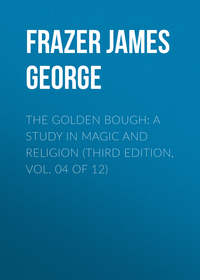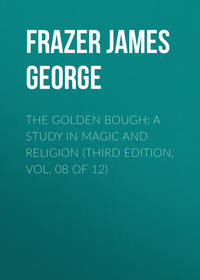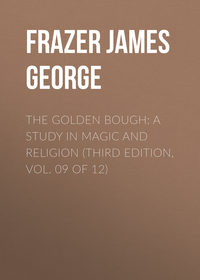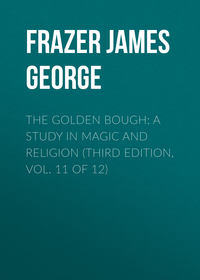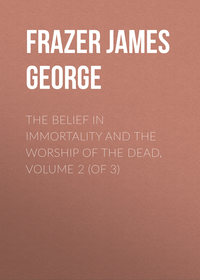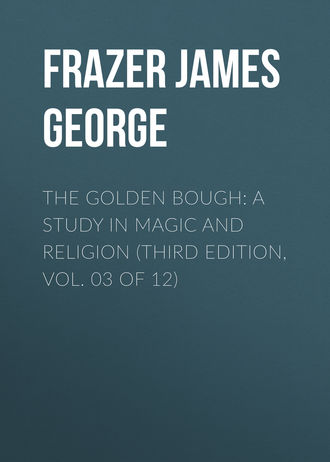 полная версия
полная версияThe Golden Bough: A Study in Magic and Religion (Third Edition, Vol. 03 of 12)
237
W. W. Skeat, op. cit. pp. 569 sq.
238
W. W. Skeat, op. cit. pp. 574 sq.
239
W. W. Skeat, op. cit. pp. 576 sq.
240
Lysias, Or. vi. 51, p. 51 ed. C. Scheibe. The passage was pointed out to me by my friend Mr. W. Wyse. As to the mutilation of the Hermae, see Thucydides, vi. 27-29, 60 sq.; Andocides, Or. i. 37 sqq.; Plutarch, Alcibiades, 18.
241
Above, p. 69.
242
J. B. McCullagh, in The Church Missionary Gleaner, xiv. No. 164 (August 1887), p. 91. The same account is copied from the “North Star” (Sitka, Alaska, December 1888) in Journal of American Folk-lore, ii. (1889) pp. 74 sq. Mr. McCullagh's account (which is closely followed in the text) of the latter part of the custom is not quite clear. It would seem that failing to find the soul in the head-doctor's box it occurs to them that he may have swallowed it, as the other doctors were at first supposed to have done. With a view of testing this hypothesis they hold him up by the heels to empty out the soul; and as the water with which his head is washed may possibly contain the missing soul, it is poured on the patient's head to restore the soul to him. We have already seen that the recovered soul is often conveyed into the sick person's head.
243
Fr. Boas in Eleventh Report on the North-Western Tribes of Canada, p. 571 (Report of the British Association for 1896). For other examples of the recapture or recovery of lost, stolen, and strayed souls, in addition to those which have been cited in the preceding pages, see J. N. Vosmaer, Korte Beschrijving van het Zuid-oostelijk Schiereiland van Celebes, pp. 119-123 (this work, of which I possess a copy, forms part of a Dutch journal which I have not identified; it is dated Batavia, 1835); J. G. F. Riedel, “De Topantunuasu of oorspronkelijke volksstammen van Central Selebes,” Bijdragen tot de Taal- Land- en Volkenkunde van Nederlandsch-Indië, xxxv. (1886) p. 93; J. B. Neumann, “Het Pane- en Bilastroom-gebeid,” Tijdschrift van het Nederlandsch Aardrijkskundig Genootschap, Tweede Serie, dl. iii., Afdeeling, meer uitgebreide artikelen, No. 2 (1886), pp. 300 sq.; J. L. van der Toorn, “Het animisme bei den Minangkabauer,” Bijdragen tot de Taal- Land- en Volkenkunde van Nederlandsch-Indië, xxxix. (1890) pp. 51 sq.; H. Ris, “De onderafdeeling Klein Mandailing Oeloe en Pahantan,” Bijdragen tot de Taal- Land- en Volkenkunde van Nederlandsch-Indië, xlvi. (1896) p. 529; C. Snouck Hurgronje, De Atjéhers (Batavia and Leyden, 1893-4), i. 426 sq.; W. W. Skeat, Malay Magic, pp. 49-51, 452-455, 570 sqq.; Journal of the Anthropological Institute, xxiv. (1895) pp. 128, 287; Chimkievitch, “Chez les Bouriates de l'Amoor,” Tour du monde, N.S. iii. (1897) pp. 622 sq.; Father Ambrosoli, “Notice sur l'île de Rook,” Annales de la Propagation de la Foi, xxvii. (1855) p. 364; A. Bastian, Die Völker des östlichen Asien, ii. 388, iii. 236; id., Völkerstämme am Brahmaputra, p. 23; id., “Hügelstämme Assam's,” Verhandlungen der Berlin. Gesell. für Anthropol., Ethnol. und Urgeschichte, 1881, p. 156; Shway Yoe, The Burman, i. 283 sq., ii. 101 sq.; G. M. Sproat, Scenes and Studies of Savage Life, p. 214; J. Doolittle, Social Life of the Chinese, pp. 110 sq. (ed. Paxton Hood); T. Williams, Fiji and the Fijians,2 i. 242; E. B. Cross, “On the Karens,” Journal of the American Oriental Society, iv. (1854) pp. 309 sq.; A. W. Howitt, “On some Australian Beliefs,” Journal of the Anthropological Institute, xiii. (1884) pp. 187 sq.; id., “On Australian Medicine Men,” Journ. Anthrop. Inst. xvi. (1887) p. 41; E. P. Houghton, “On the Land Dayaks of Upper Sarawak,” Memoirs of the Anthropological Society of London, iii. (1870) pp. 196 sq.; L. Dahle, “Sikidy and Vintana,” Antananarivo Annual and Madagascar Annual, xi. (1887) pp. 320 sq.; C. Leemius, De Lapponibus Finmarchiae eorumque lingua, vita et religione pristina commentatio (Copenhagen, 1767), pp. 416 sq.; A. E. Jenks, The Bontoc Igorot (Manilla, 1905), pp. 199 sq.; C. G. Seligmann, The Melanesians of British New Guinea (Cambridge, 1910), pp. 185 sq. My friend W. Robertson Smith suggested to me that the practice of hunting souls, which is denounced in Ezekiel xiii. 17 sqq., may have been akin to those described in the text.
244
J. G. F. Riedel, De sluik- en kroesharige rassen tusschen Selebes en Papua, p. 440.
245
A. Bastian, Die Völker des östlichen Asien, v. 455.
246
J. G. F. Riedel, op. cit. p. 340.
247
N. Adriani en A. C. Kruijt, “Van Posso naar Parigi, Sigi en Lindoe,” Mededeelingen van wege het Nederlandsche Zendelinggenootschap, xlii. (1898) p. 511; compare A. C. Kruijt, ib. xliv. (1900) p. 247.
248
A. C. Kruijt, “Eenige ethnografische aanteekeningen omtrent de Toboengkoe en de Tomori,” op. cit. xliv. (1900) p. 226.
249
Annales de l'Association de la Propagation de la Foi, iv. (1830) p. 481.
250
Rev. J. Roscoe, in a letter to me dated Mengo, Uganda, May 26, 1904.
251
R. E. Dennett, “Bavili Notes,” Folk-lore, xvi. (1905) p. 372; id., At the Back of the Black Man's Mind (London, 1906), p. 79.
252
Dudley Kidd, The Essential Kafir, p. 84.
253
Dudley Kidd, Savage Childhood, p. 68.
254
C. W. Hobley, “British East Africa,” Journal of the Anthropological Institute, xxxiii. (1903) pp. 327 sq.
255
J. J. M. de Groot, The Religious System of China, iv. 84 sq.
256
E. Modigliani, Viaggio a Nías, p. 620, compare p. 624.
257
R. H. Codrington, The Melanesians, p. 184.
258
R. H. Codrington, op. cit. p. 176.
259
Fr. Boas, in Ninth Report on the North-Western Tribes of Canada, pp. 461 sq. (Report of the British Association for 1894).
260
J. J. M. de Groot, The Religious System of China, i. 94, 210 sq.
261
E. H. Man, “Notes on the Nicobarese,” Indian Antiquary, xxviii. (1899) pp. 257-259. Compare Sir R. C. Temple, in Census of India, 1901, iii. 209.
262
W. W. Skeat, Malay Magic, p. 143.
263
J. Dawson, Australian Aborigines, p. 54.
264
Mohammed Ebn-Omar El-Tounsy, Voyage au Darfour, traduit de l'Arabe par le Dr. Perron (Paris, 1845), p. 347.
265
W. W. Skeat, Malay Magic, p. 306.
266
[Aristotle] Mirab. Auscult. 145 (157); Geoponica, xv. 1. In the latter passage, for κατάγει ἑαυτήν we must read κατάγει αὐτόν, an emendation necessitated by the context, and confirmed by the passage of Damïrï quoted and translated by Bochart, Hierozoicon, i. col. 833, “cum ad lunam calcat umbram canis, qui supra tectum est, canis ad eam [scil. hyaenam] decidit, et ea illum devorat.” Compare W. Robertson Smith, The Religion of the Semites,2 p. 129.
267
Dudley Kidd, Savage Childhood, p. 71.
268
W. Crooke, in Indian Antiquary, xix. (1890) p. 254.
269
Spencer and Gillen, Northern Tribes of Central Australia, p. 612.
270
M. R. Pedlow, in Indian Antiquary, xxix. (1900) p. 60.
271
W. Cornwallis Harris, The Highlands of Aethiopia (London, 1844), i. 158.
272
Dudley Kidd, The Essential Kafir, p. 313.
273
D. Kidd, op. cit. p. 356.
274
Dudley Kidd, Savage Childhood, p. 70.
275
Panjab Notes and Queries, i. p. 15, § 122.
276
Fr. Boas, in Sixth Report on the North-Western Tribes of Canada, pp. 92, 94 (separate reprint from the Report of the British Association for 1890); compare id. in Seventh Report, etc., p. 13 (separate reprint from the Rep. Brit. Assoc. for 1891).
277
A. W. Howitt, “The Jeraeil, or Initiation Ceremonies of the Kurnai Tribe,” Journal of the Anthropological Institute, xiv. (1885) p. 316.
278
Miss Mary E. B. Howitt, Folk-lore and Legends of some Victorian Tribes (in manuscript).
279
A. W. Howitt, Native Tribes of South-East Australia, p. 266.
280
A. W. Howitt, op. cit. p. 267.
281
A. W. Howitt, op. cit. pp. 256 sq.
282
A. W. Howitt, op. cit. pp. 280 sq. Compare J. Dawson, Australian Aborigines, pp. 32 sq.
283
Partly from notes sent me by my friend the Rev. J. Roscoe, partly from Sir H. Johnston's account (The Uganda Protectorate, ii. 688). In his printed notes (Journal of the Anthropological Institute, xxxii. (1902) p. 39) Mr. Roscoe says that the mother-in-law “may be in another room out of sight and speak to him through the wall or open door.”
284
Father Picarda, “Autour du Mandera, Notes sur l'Ouzigoua, l'Oukwéré et l'Oudoé (Zanguebar),” Missions Catholiques, xviii. (1886) p. 286.
285
Father Porte, “Les Réminiscences d'un missionnaire du Basutoland,” Missions Catholiques, xxviii. (1896) p. 318.
286
H. H. Romily and Rev. George Brown, in Proceedings of the Royal Geographical Society, N.S. ix. (1887) pp. 9, 17.
287
R. H. Codrington, The Melanesians, p. 43.
288
J. G. Bourke, On the Border with Crook, p. 132. More evidence of the mutual avoidance of mother-in-law and son-in-law among savages is collected in my Totemism and Exogamy; see the Index, s. v. “Mother-in-law.” The custom is probably based on a fear of incest between them. To the almost universal rule of savage life that a man must avoid his mother-in-law there is a most remarkable exception among the Wahehe of German East Africa. In that tribe a bridegroom must sleep with his mother-in-law before he may cohabit with her daughter. See Rev. H. Cole, “Notes on the Wagogo of German East Africa,” Journal of the Anthropological Institute, xxxii. (1902) p. 312.
289
O. Dapper, Description de l'Afrique, p. 312; H. Ling Roth, Great Benin, p. 119; Missions Catholiques, xv. (1883) p. 110; J. Roscoe, “Further Notes on the Manners and Customs of the Baganda,” Journal of the Anthropological Institute, xxxii. (1902) p. 67.
290
Dio Chrysostom, Or. lxvii. vol. ii. p. 230, ed. L. Dindorf.
291
J. G. F. Riedel, De sluik- en kroesharige rassen tusschen Selebes en Papua, p. 61.
292
W. W. Gill, Myths and Songs of the South Pacific, pp. 284 sqq.
293
W. W. Skeat and C. O. Blagden. Pagan Races of the Malay Peninsula (London, 1906), ii. 110.
294
The Rev. J. Roscoe, in a letter to me dated Mengo, Uganda, May 26, 1904.
295
T. Arbousset et F. Daumas, Voyage d'exploration (Paris, 1842), p. 291; Dudley Kidd, The Essential Kafir, pp. 83, 303; id., Savage Childhood, p. 69. In the last passage Mr. Kidd tells us that “the mat was not held up in the sun, but was placed in the hut at the marked-off portion where the itongo or ancestral spirit was supposed to live; and the fate of the man was divined, not by the length of the shadow, but by its strength.”
296
Theocritus, i. 15 sqq.; Philostratus, Heroic. i. 3; Porphyry, De antro nympharum, 26; Lucan, iii. 423 sqq.; Drexler, s. v. “Meridianus daemon,” in Roscher's Lexikon der griech. und röm. Mythologie, ii. 2832 sqq.; Bernard Schmidt, Das Volksleben der Neugriechen, pp. 94 sqq., 119 sq.; Georgeakis et Pineau, Folk-lore de Lesbos, p. 342; A. de Nore, Coutumes, mythes, et traditions des provinces de France, pp. 214 sq.; J. Grimm, Deutsche Mythologie,4 ii. 972; C. L. Rochholz, Deutscher Glaube und Brauch, i. 62 sqq.; E. Gerard, The Land beyond the Forest, i. 331; “Lettre du curé de Santiago Tepehuacan,” Bulletin de la Société de Géographie (Paris), IIme Série, ii. (1834) p. 180; N. von Stenin, “Die Permier,” Globus, lxxi. (1897) p. 374; D. Louwerier, “Bijgeloovige gebruiken, die door die Javanen worden in acht genomen,” Mededeelingen van wege het Nederlandsche Zendelinggenootschap, xlix. (1905) p. 257.
297
Schol. on Aristophanes, Frogs, 293.
298
Pausanias, viii. 38. 6; Polybius, xvi. 12. 7; Plutarch, Quaestiones Graecae, 39.
299
Th. Vernaleken, Mythen und Bräuche des Volkes in Österreich, p. 341; Reinsberg-Düringsfeld, Das festliche Jahr, p. 401; A. Wuttke, Der deutsche Volksaberglaube,2 p. 207, § 314.
300
M. J. van Baarda, “Fabelen, Verhalen en Overleveringen der Galelareezen,” Bijdragen tot de Taal- Land- en Volkenkunde van Nederlandsch-Indië, xlv. (1895) p. 459.
301
J. H. Weeks, “Notes on some Customs of the Lower Congo People,” Folk-lore, xix. (1908) p. 422.
302
B. Schmidt, Das Volksleben der Neugriechen (Leipsic, 1871), pp. 196 sq.
303
Georgeakis et Pineau, Folk-lore de Lesbos, pp. 346 sq.
304
A. Strausz, Die Bulgaren (Leipsic, 1898), p. 199; W. R. S. Ralston, Songs of the Russian People, p. 127.
305
W. Schmidt, Das Jahr und seine Tage in Meinung und Brauch der Romänen Siebenbürgens (Hermannstadt, 1866), p. 27; E. Gerard, The Land beyond the Forest, ii. 17 sq. Compare F. S. Krauss, Volksglaube und religiöser Brauch der Südslaven, p. 161.
306
Mgr. Bruguière, in Annales de l'Association de la Propagation de la Foi, v. (1831) pp. 164 sq.; Pallegoix, Description du royaume Thai ou Siam, ii. 50-52.
307
A. Fytche, Burma, Past and Present (London, 1878), i. 251 note.
308
On such practices in general, see E. B. Tylor, Primitive Culture,2 i. 104 sqq.; F. Liebrecht, Zur Volkskunde, pp. 284-296; F. S. Krauss, “Der Bauopfer bei den Südslaven,” Mittheilungen der Anthropologischen Gesellschaft in Wien, xvii. (1887) pp. 16-24; P. Sartori, “Über das Bauopfer,” Zeitschrift für Ethnologie, xxx. (1898) pp. 1-54; E. Westermarck, Origin and Development of the Moral Ideas (London, 1906-1908), i. 461 sqq. For some special evidence, see H. Oldenberg, Die Religion des Veda, pp. 363 sqq. (as to ancient India); Sonnerat, Voyage aux Indes Orientales et à la Chine, ii. 47 (as to Pegu); Guerlach, “Chez les sauvages Bahnars,” Missions Catholiques, xvi. (1884) p. 82 (as to the Sedans of Cochin-China); W. H. Furness, Home-life of Borneo Head-hunters, p. 3 (as to the Kayans and Kenyahs of Burma); A. C. Kruijt, “Van Paloppo naar Posso,” Mededeelingen van wege het Nederlandsche Zendelinggenootschap, xlii. (1898) p. 56 note (as to central Celebes); L. Hearn, Glimpses of Unfamiliar Japan (London, 1894), i. 148 sq.; H. Ternaux-Compans, Essai sur l'ancien Cundinamarca, p. 70 (as to the Indians of Colombia). These customs are commonly called foundation-sacrifices. But the name is inappropriate, as Prof. H. Oldenberg has rightly observed, since they are not sacrifices but charms.
309
D. F. van Braam Morris, in Tijdschrift voor Indische Taal- Land- en Volkenkunde, xxxiv. (1891) p. 224.
310
J. H. de Vries, “Reis door eenige eilandgroepen der Residentie Amboina,” Tijdschrift van het koninklijk Nederlandsch Aardrijkskundig Genootschap, Tweedie Serie, xvii. (1900) pp. 612 sq.
311
E. H. Mann, Aboriginal Inhabitants of the Andaman Islands, p. 94.
312
T. Williams, Fiji and the Fijians,2 i. 241. However, the late Mr. Lorimer Fison wrote to me that this reported belief in a bright soul and a dark soul “is one of Williams' absurdities. I inquired into it on the island where he was, and found that there was no such belief. He took the word for ‘shadow,’ which is a reduplication of yalo, the word for soul, as meaning the dark soul. But yaloyalo does not mean the soul at all. It is not part of a man as his soul is. This is made certain by the fact that it does not take the possessive suffix yalo-na = his soul; but nona yaloyalo = his shadow. This settles the question beyond dispute. If yaloyalo were any kind of soul, the possessive form would be yaloyalona” (letter dated August 26, 1898).
313
James Chalmers, Pioneering in New Guinea (London, 1887), p. 170.
314
Father Lambert, Mœurs et superstitions des Néo-Calédoniens (Nouméa, 1900), pp. 45 sq.
315
M. J. van Baarda, “Fabelen, Verhalen en Overleveringen der Galelareezen,” Bijdragen tot de Taal- Land- en Volkenkunde van Nederlandsch-Indië, xlv. (1895) p. 462.
316
B. de Sahagun, Histoire générale des choses de la Nouvelle-Espagne (Paris, 1880), p. 314. The Chinese hang brass mirrors over the idols in their houses, because it is thought that evil spirits entering the house and seeing themselves in the mirrors will be scared away (China Review, ii. 164).
317
G. Vuillier, “Chez les magiciens et les sorciers de la Corrèze,” Tour du monde, N.S. v. (1899) pp. 522, 524.
318
H. Callaway, Nursery Tales, Traditions, and Histories of the Zulus (Natal and London, 1868), p. 342.
319
T. Arbousset et F. Daumas, Voyage d'exploration au nord-est de la colonie du Cap de Bonne-Espérance, p. 12; T. Lindsay Fairclough, “Notes on the Basuto,” Journal of the African Society, No. 14 (January 1905), p. 201.
320
R. H. Codrington, “Religious Beliefs and Practices in Melanesia,” Journ. Anthrop. Inst. x. (1881) p. 313; id., The Melanesians, p. 186.
321
Fragmenta philosophorum Graecorum, ed. F. G. A. Mullach, i. 510; Artemidorus, Onirocr. ii. 7; Laws of Manu, iv. 38 (p. 135, G. Bühler's translation, Sacred Books of the East, vol. xxv.).
322
See above, p. 37.
323
A. Wuttke, Der deutsche Volksaberglaube,2 pp. 429 sq., § 726.
324
A. Wuttke, l. c.; E. Monseur, Le Folklore Wallon, p. 40.
325
Folk-lore Journal, iii. (1885) p. 281; T. F. Thiselton Dyer, English Folk-lore, p. 109; J. Napier, Folk-lore, or Superstitious Beliefs in the West of Scotland, p. 60; W. Ellis, History of Madagascar, i. 238. Compare A. Grandidier, “Des rites funéraires chez les Malgaches,” Revue d'Ethnographie, v. (1886) p. 215.
326
S. Weissenberg, “Die Karäer der Krim,” Globus, lxxxiv. (1903) p. 143; id. “Krankheit und Tod bei den südrussischen Juden,” Globus, xci. (1907) p. 360.
327
Panjab Notes and Queries, ii. p. 169, § 906.
328
J. V. Grohmann, Aberglauben und Gebräuche aus Böhmen und Mähren, p. 151, § 1097; Folk-lore Journal, vi. (1888) pp. 145 sq.: Panjab Notes and Queries, ii. p. 61, § 378.
329
J. G. Frazer, “On certain Burial Customs as illustrative of the Primitive Theory of the Soul,” Journal of the Anthropological Institute, xv. (1886) pp. 82 sqq. Among the heathen Arabs, when a man had been stung by a scorpion, he was kept from sleeping for seven days, during which he had to wear a woman's bracelets and earrings (Rasmussen, Additamenta ad historiam Arabum ante Islamismum, p. 65, compare p. 69). The old Mexican custom of masking and the images of the gods so long as the king was sick (Brasseur de Bourbourg, Histoire des nations civilisées du Mexique et de l'Amérique-Centrale, iii. 571 sq.) may perhaps have been intended to prevent the images from drawing away the king's soul.
330
W. R. S. Ralston, Songs of the Russian People, p. 117. The objection, however, may be merely Puritanical. W. Robertson Smith informed me that the peculiarities of the Raskolniks are largely due to exaggerated Puritanism.
331
E. W. Nelson, “The Eskimo about Bering Strait,” Eighteenth Annual Report of the Bureau of American Ethnology, Part I. (Washington, 1899) p. 422.
332
J. Owen Dorsey, “A Study of Siouan Cults,” Eleventh Annual Report of the Bureau of Ethnology (Washington, 1894), p. 484; id. “Teton Folk-lore,” American Anthropologist, ii. (1889) p. 143.
333
Maximilian Prinz zu Wied, Reise in das innere Nord-America, i. 417.
334
Ibid. ii. 166.
335
C. Lumholtz, Unknown Mexico (London, 1903), i. 459 sq.
336
A. Simson, “Notes on the Jivaros and Canelos Indians,” Journal of the Anthropological Institute, ix. (1880) p. 392.
337
D. Forbes, in Journal of the Ethnological Society of London, ii. (1870) p. 236.




